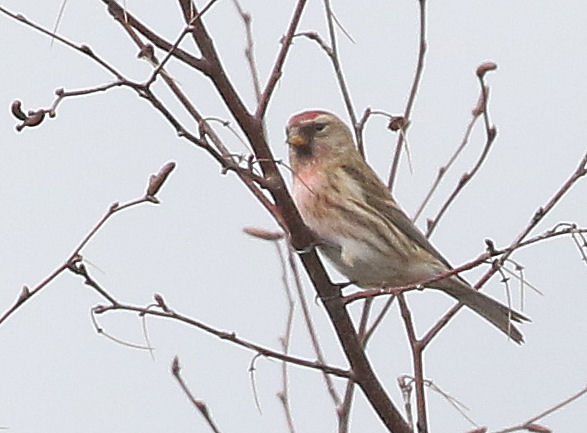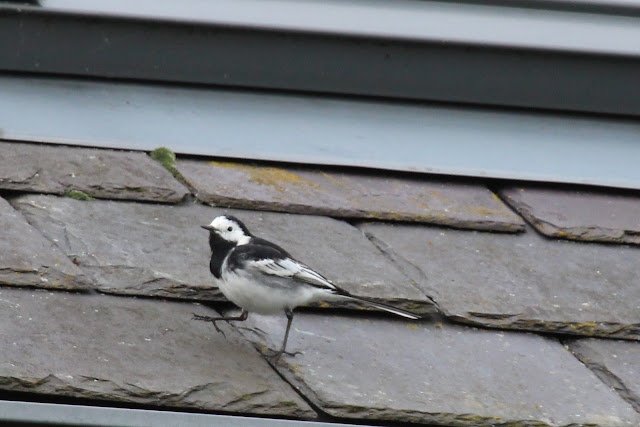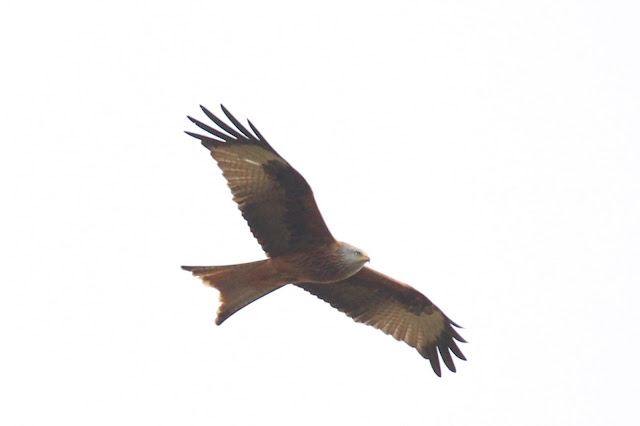Female Grey Wagtail (c) 2019 Dave Hill
 This week the weather on Tuesday was very nice, as was that on Friday morning, but in-between that the climate was rather grim and wet.
This week the weather on Tuesday was very nice, as was that on Friday morning, but in-between that the climate was rather grim and wet.
At Sunk Island on Monday afternoon a pair of Buzzards were sitting side-by-side. Meanwhile at home 3 female Siskins spent a couple of days in the garden. It was so dark only one photo wasn't blurred!
Buzzards
ditto
Female Siskin
On Tuesday we went to North Cliffe Wood as planned. Unfortunately, it was very overcast, but at least it stayed dry. We saw several Marsh Tits, but it was too dark for photography. Again, there was no sign of any Willow Tits. Perhaps, they have died out here? The redwings seemed to have moved on. There was a lot of birdsong, mainly from Robins, Wrens Great Tits, a Song Thrush, and eventually a Coal Tit. All we are waiting for now are the influx of summer songsters. James spotted and identified a Treecreeper.
A Fidget of Linnets
A Parcel of Linnets
A recently ploughed field had several Pied Wagtails, which seemed a rather unusual farmland bird. Then a massive flock of finches were seen. It was only when they flew closer that we were able to see that a great number of them were Linnets. On Friday I learned from an afternoon member that these are called a fidget, but they can also be referred to a parcel of Linnets. A few minutes later Steve found a small flock of Redpolls, which we were able to observe for a couple of minutes.
Nuthatch
On Wednesday the forecast wasn't too bad, so we carried on to Fairburn Ings. The forecast wasn't correct. The afternoon in particular the weather was appalling - almost constant rain, many of it very heavy indeed. We tried to dodge the worse bits by keeping under cover at crucial times. we spent longer under cover than we would if it had stayed fine. A Nuthatch at the visitor centre was new compared with last week, as were a couple of Willow Tits - one in the same location and another near the "Kingfisher" screen. A female Bullfinch came down to the bird table, which also didn't happen last week. Male Bullfinches were soon spotted as we began to explore the reserve.
Male Bullfinch
Bullfinch (c) 2019 Aileen Urquhart
Heron
Miles' real Heron
Miles's Real Heron(c) 2019 Aileen Urquhart
Ditto
We shared cars to Lin Dyke. Both groups saw a Goosander, a few Goldeneye, Wigeon and Pochard here, and the afternoon had a Whooper Swan, and a drake Pintail. Some local gents points out the sleeping Whooper Swan, which eventually raised its head to prove its identity, perhaps that was also there in the morning, but it kept its head down? On the walk to the River Aire we came across a flock of c.40 Redpoll, some of whom had a pink breast. They were absent after lunch, but had been replaced by a Chiffchaff. There was another one at the Lin Dyke car park, which was actually singing.
Redpoll - a one-in-ten male
Ditto
Ditto
Lesser Redpoll (c) 2019 Aileen Urquhart
Lesser Redpoll (c) 2019 Tony Robinson
Reed Bunting (c) 2019 Tony Robinson
Female Chaffinch (c) 2019 Aileen Urquhart
Canada Geese (c) 2019 Tony Robinson
On Thursday a cold wind was forecast, so Bempton was cancelled in favour of North Cave Wetlands. This was fortuitous because the forecast was inaccurate, it was much worse than they said - it rained all morning, heavily at times. Luckily, the rain was more scarce in the afternoon. In total the morning group saw c.45 species, and the afternoon group achieved an all time record of 47 making the annual total 83 species so far.
An archive picture of a Mediterranean Gull [right]
The morning group went round in an anti-clockwise direction. Jan spotted and identified correctly a Mediterranean Gull among the Black-headed Gulls, and ensured everyone else saw it too. Usual suspects were Great Crested Grebes, Wigeon, Oystercatchers, Tufted Ducks, Pochard etc. As we neared the concluding straight we found a Chiffchaff busy looking for insects. One of the final birds seen in the afternoon was a Snipe, which dropped in, but then became almost impossible to see!
Mistle Thrush
On Friday we had our final visit of the winter to the South Wolds. The morning was beautiful, and we soon noticed Sparrowhawks soaring on the breeze. The afternoon was cloudier, but the walk was enhanced by a pair of Mistle Thrushes and a lone Fieldfare.
Fieldfare
Fieldfare (c) 2019 Mike Woods
We reached the end of the houses and watched more Sparrowhawks being mobbed by Crows. In the afternoon we managed a view of the Great Spotted Woodpecker, whilst both groups heard distant yaffling Green Woodpeckers, but unlike last week the bird wasn’t observed.
Great Spotted Woodpecker
We left Dave at the water area, and he concentrated on obtaining Grey Wagtail photos. He was about to get an even better image, when a pair of noisy dog owners frightened this dainty bird aware, and unfortunately it never returned. However, after lunch we saw it again briefly, but the male was more distant and the one near the water more skittish.
Female Grey Wagtail (c) 2019 Dave Hill
The climb up the hill led us to a pair of Pied Wagtails, which were either courting or fighting - it was hard to be sure! These had vanished when the weather had become much cooler and windier in the afternoon.
Pied Wagtail (c) 2019 Jane Robinson
ditto
Male Grey Wagtail
ditto
Female Grey Wagtail (c) 2019 Mike Woods
On the hillside we did see a couple of Red Kites, but the final area was awash with other birds of prey, especially in the afternoon. We had a male Marsh Harrier pass through, and many Buzzards. However, the highlight were two Peregrines, who did not appear to be a pair.
Red Kite (c) 2019 Jane Robinson
ditto
ditto
ditto
Sparrowhawk (c) 2019 Mike Woods
Ditto
Peregrine
ditto
ditto
ditto
The morning group encountered 32 species, but the afternoon session came across 37 species, which included 2 new species for the term, bringing the total up to 84 for 2019.













































No comments:
Post a Comment